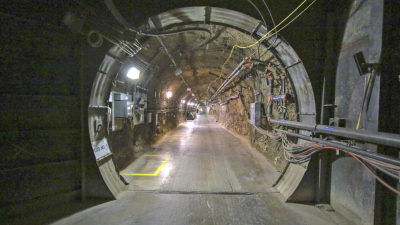US carries out subcritical nuclear test count, others may follow

This undated photo shows an underground facility in Nevada where a U.S. subcritical test was conducted.
A Japanese peace research institute discovered in March that an additional subcritical nuclear test was added to a U.S. tally due to a change in its criteria, with a series of plutonium experiments from 2007 now being grouped together to represent a single test.
Peace Depot Inc., based in Yokohama near Tokyo, filed a request last September with the U.S. Department of Energy’s National Nuclear Security Administration under the Freedom of Information Act to disclose the details after it was revealed last year that the number of U.S. subcritical nuclear tests had risen from a total of 32 to 33.
Jill Hruby, administrator of the NNSA, disclosed the new figure to the public at the Comprehensive Nuclear Test Ban Treaty’s science and technology conference last June in Vienna.
The NNSA is responsible for regularly assessing the reliability of the nation’s nuclear weapons stockpile in a manner consistent with the existing U.S. nuclear testing moratorium.
The NNSA explained that the series of plutonium experiments, referred to as the Thermos experiments, were eventually included in the official count of subcritical nuclear tests because the criteria defining what constituted such an experiment were broadened.
The Thermos experiments, carried out at an underground test site in Nevada between February and May of 2007, had been considered different from the subcritical experiments because they used lower quantities of plutonium and high explosives, among other reasons.
Peace Depot Special Adviser Hiromichi Umebayashi, who was in charge of the organization’s investigation, pointed out that U.S. nuclear information is often classified, leading to important data sometimes not being disclosed.
“We need to keep a close eye on developments to prevent the resumption of nuclear testing,” Umebayashi said.
The United States voluntarily stopped carrying out underground nuclear tests in 1992 and shifted to subcritical testing, which does not produce self-sustaining nuclear fission chain reactions.
In subcritical experiments, chemical high explosives generate massive pressures on nuclear weapons materials, such as plutonium.
Under the administration of President Joe Biden, subcritical tests were conducted in June and September of 2021, with the latest one known as Nightshade C.
Hiroshima and Nagasaki, the two Japanese cities to have been struck with atomic bombs dropped by the United States in the final stages of World War II, have lodged their protests with the U.S. government, saying subcritical nuclear tests violate the spirit of the CTBT.
Countries like UK and Pakistan may remain inactive due to numerous constraints but other nuclear powers which are independent of USA thought process on the subject like Russia, China and India now may decide to conduct few sub critical tests of their own to upgrade their arsenals with France and Israel watching.



